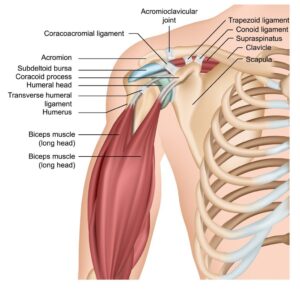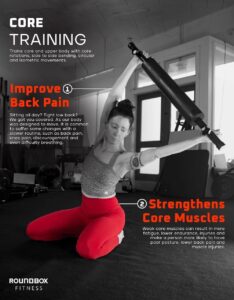You’re about to embark on a journey that’ll change how you view shoulder health. In this article, we’ll dive deep into the anatomy of your shoulder, explore common injuries due to stability neglect, and reveal exercises that’ll enhance its strength.
You’ll also discover preventive measures for daily life and advanced training tips. So, let’s unlock the key to lasting shoulder health together!
It’s time to prioritize your wellbeing.
Key Takeaways
- Shoulder stability is crucial for preventing injuries and enhancing overall function.
- Regular shoulder stability exercises reduce the risk of injuries and promote healthy muscle function.
- Maintaining good posture and incorporating regular shoulder stretches and strengthening exercises are preventive measures for shoulder health.
- Nutrients, inflammation, and sleep play a significant role in shoulder health and recovery.
Understanding Shoulder Stability and Its Importance
You’ve got to understand, shoulder stability isn’t just crucial for athletes, it’s vital for everyone including you, especially when you consider your everyday tasks and movements. Shoulder stability benefits are numerous. It involves the intricate coordination of muscles and ligaments in your shoulder joint to maintain its correct position during movement. This prevents injuries and enhances overall function.
Emphasizing on shoulder stability training is important as it strengthens your rotator cuff muscles which are key in maintaining the ball of your upper arm within the socket of your shoulder blade. Balancing mobility vs stability can seem like a tightrope walk, but it’s essential for optimal function. Too much mobility can lead to instability and potential injury while too little may restrict movement.
Functional shoulder exercises that focus on both strength and flexibility can help in achieving this balance. Exercises such as plank walkouts or wall slides promote both aspects simultaneously ensuring a stable yet mobile shoulder joint.
The importance of shoulder stability cannot be overstated. Not only does it improve physical performance but also aids in carrying out routine activities with ease – lifting items overhead or reaching out for something across the table becomes easier when your shoulders are strong and stable.
The Anatomy of a Stable Shoulder: Bones, Muscles, and Ligaments

Understanding the structure of this vital joint, including its bones, muscles, and ligaments, is crucial to your overall fitness regimen. The shoulder anatomy is intricate and complex. It’s an interconnected system where each part plays a significant role in maintaining shoulder stability.
- Bones: The shoulder consists of three main bones: the humerus (upper arm bone), clavicle (collarbone), and scapula (shoulder blade). These form two joints that work together for full range movement.
- Muscles: Four primary muscles – supraspinatus, infraspinatus, teres minor, and subscapularis make up the rotator cuff which provides stability.
- Ligaments: Connective tissue linking bones to other bones are key players in holding your shoulder components together.
- Tendons: Attach muscles to bones enabling motion when muscles contract.
Implementing effective shoulder stability exercises into your routine can strengthen these parts individually and improve their combined function. This not only enhances performance but also helps prevent injuries.
Understanding the shoulder muscles and ligaments’ functionality could guide you towards more beneficial workouts. Remember: appreciating the importance of shoulder stability is not just about strength—it’s about lasting health for one of your body’s most versatile joints.
Common Shoulder Injuries: The Price of Neglecting Stability

Let’s dive into the most common injuries that can occur when we neglect the balance and integrity of our upper arm joint. Rotator cuff tears, impingements, and dislocations are all common shoulder injuries you might encounter. These occur due to various causes of shoulder instability, overuse, sudden trauma, or even age-related wear and tear.
The signs of shoulder instability aren’t always obvious. You might experience a vague sense of discomfort in your upper arm or difficulty carrying out routine tasks. In more severe cases, you may notice a weakness in your arm, recurring dislocation, or a visible deformity.
Treatment for shoulder instability varies based on severity. Physiotherapy often proves beneficial in restoring stability through exercises designed to strengthen the surrounding muscles. However, severe cases may require surgical intervention.
Preventing shoulder instability is key to maintaining healthy muscle function. Regularly engaging in shoulder stability exercises promotes strength and dexterity while reducing injury risk. Remember, consistency is essential – it’s far easier to prevent an issue than address one that’s already taken root.
Curt Ligot Owner Roundbox Fitness
Essential Shoulder Stability Exercises for Optimal Health
Moving on, we’ll jump into some vital workouts that’ll target the upper arm area and promote overall muscle wellness. This journey will aid in enhancing your shoulder stability, a key aspect of shoulder health.

Let’s explore four essential exercises designed for this purpose:
- Shoulder Press: This technique strengthens your deltoids and engages your core. Modifications can include seated or standing versions.
- Lat Raises: These specifically target your lateral deltoid muscles, improving shoulder health over time.
- Front Raises: By focusing on anterior deltoids, this exercise contributes to balance in the shoulder region.
- Rear Delt Flys: By targeting posterior deltoids, they provide comprehensive strengthening.
Each of these exercises offers exclusive benefits such as improved muscular endurance, greater joint mobility, and enhanced overall stability.
Embracing these routines will not only fortify your shoulders but also contribute to holistic physical well-being. Remember to perform each with controlled movements and mindful breathing – it’s not about speed but precision and form.
With consistent practice following these guidelines, you’re sure to reap the therapeutic benefits while ensuring lasting shoulder strength and health!
Preventive Measures: Tips to Maintain Shoulder Health in Daily Life
Next, we’re going to tackle some everyday habits and lifestyle tweaks you can make to ensure your upper body remains robust and injury-free. Your shoulder health is impacted by daily activities as much as exercise. Therefore, a few changes in routine can boost your shoulder stability.
First, focus on tips for posture. Keep your spine straight while sitting or standing – this alignment reduces stress on your shoulders. Next, consider an ergonomic workstation setup; adjust your chair height so that feet rest flat on the floor, your arms fall naturally at desk level, minimizing tension in the shoulders.
Carrying techniques also play a significant role in shoulder health. When lifting heavy items like groceries or bags, ensure you balance weight evenly across both hands to prevent overloading one side of the body.
Finally, incorporate regular shoulder stretches into your routine. These exercises increase flexibility and circulation around the shoulder joint, reducing the risk of injury. Shoulder strengthening exercises are equally important; they build muscle mass providing additional support for the intricate structure of bones and ligaments within the shoulder region.
Advanced Training: Taking Shoulder Stability to the Next Level
Now that you’re familiar with preventive measures and how to maintain shoulder health in daily life, let’s take things up a notch. Are you ready to push beyond the basics?
It’s time to delve into advanced techniques for enhancing shoulder stability. This is where rotator strengthening comes into play, an essential component often overlooked due to stability misconceptions.
Here are some critical points to keep in mind:
- Embrace advanced techniques: These will challenge your muscles and lead to significant improvements in shoulder strength and stability.
- Understand the importance of rotator strengthening: The rotator cuff plays a pivotal role in maintaining shoulder stability; neglecting it can lead to injuries.
- Don’t fall victim to stability misconceptions: Stability doesn’t only entail muscle strength; joint flexibility, alignment, and control are equally important.
- Adjust training frequency and exercise modifications wisely: Your body needs adequate rest between sessions for tissue repair and growth.
Remember, each person’s body responds differently. What works well for one might not work as effectively for another. Thus, when incorporating these advanced strategies into your routine, do so gradually and attentively.
The journey towards lasting shoulder health requires patience but promises rewarding results.
The Role of Diet and Lifestyle in Shoulder Health
You’re probably wondering how your diet and lifestyle choices can impact the well-being of your joints, aren’t you? Well, it’s all about nutrients, inflammation reduction, adequate sleep for recovery, and consistent exercise.
Nutrients are crucial to joint health. They help form synovial fluid that lubricates your joints and maintains shoulder integrity. Inflammation is a natural response to injury, but chronic inflammation can lead to joint damage. Foods high in omega-3 fatty acids like fish or flax seeds can combat this.
Sleep is vital too. It allows for effective recovery as during deep sleep phases our body repairs tissues damaged during the day’s activities.
Exercise promotes blood flow which carries oxygen and nutrients to your joints aiding repair processes.
| Nutrients | Sleep | Exercise |
| Forms synovial fluid | Allows tissue repair and recovery | Promotes blood flow |
| Maintains shoulder integrity | Aids in reducing inflammation through rest periods | Strengthens muscles supporting joints |
| Found in balanced diets (fruits, vegetables etc.) | Recommended 7-9 hours daily for adults | Regular moderate-intensity activity advised |
Your diet and lifestyle choices play a significant role in maintaining shoulder health. So, make wise decisions today for lasting strength tomorrow!
Conclusion
You’ve got the tools to bolster your shoulder stability now. Don’t underestimate their impact! Stick to these exercises, keep your posture in check, and nourish your body right.
Remember, a stable shoulder isn’t just about strength; it’s about lasting health too. So, step up your game and reap the benefits of a strong and healthy shoulder!
